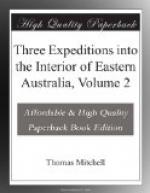CHAPTER 3.6.
Return along the bank of the Murray.
Mount Lookout.
Appearance of rain.
Chance of being cut off from the depot by the river
floods.
A savage man at home.
Tributaries of the Murray.
A storm in the night.
Traverse the land of lagoons before the floods come
down.
Traces of many naked feet along our old track.
Camp of 400 natives.
Narrow escape from the floods of the river.
Piper overtakes two youths fishing in Lake Benanee.
Description of the lake.
Great rise in the waters of the Murray.
Security of the depot.
Surrounded by inundations.
Cross to it in a bark canoe made by Tommy Came-last.
Search for the junction of the Murrumbidgee and Murray.
Mr. Stapylton reaches the junction of the rivers.
Reception by the natives of the left bank.
Passage of the Murray.
Heavy rains set in.
Row up the Murray to the junction of the Murrumbidgee.
Commence the journey upwards, along the left bank.
Strange animal.
Picturesque scenery on the river.
Kangaroos numerous.
Country improves as we ascend the river.
A region of reeds.
The water inaccessible from soft and muddy banks.
Habits of our native guides.
Natives very shy.
Piper speaks to natives on the river.
Good land on the Murray.
Wood and water scarce.
Junction of two branches.
Swan Hill.
RETURN ALONG THE BANK OF THE MURRAY.
Returning from the junction towards our last camp on the Murray we again crossed, when within a mile of that position, the dry channel we had seen on proceeding towards the north-west. It contained some deep lagoons on which were pelicans, but we crossed it where the bed was quite dry and where it presented, like many other parts occasionally under water, striking proofs of the uncertainty of seasons in these parts of Australia. Numerous dead saplings of eight or ten years growth stood there, having evidently flourished in that situation until the water again filled this channel, after so long an interval of drought, and killed them.
On reaching the firm ground beyond we came upon some old graves which had been disturbed, as the bones protruded from the earth. Piper said that the dead were sometimes dug up and eaten; but this I could not believe.
MOUNT LOOKOUT.




